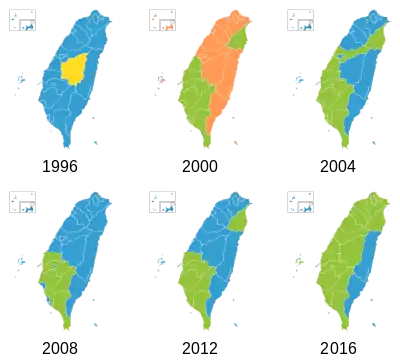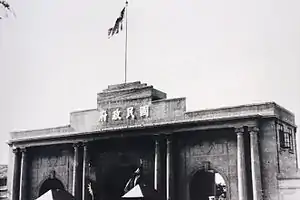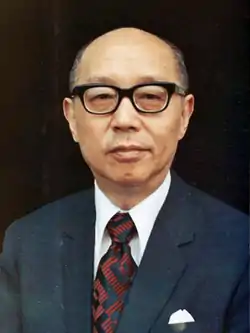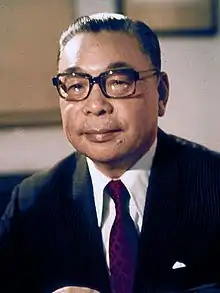President of the Republic of China
The president of the Republic of China, commonly known as the president of Taiwan[note 1] is the head of state of the Republic of China (ROC) and the commander-in-chief of the Republic of China Armed Forces.
| President of the Republic of China 中華民國總統 | |
|---|---|
 | |
 Commander-in-chief flag | |
| Office of the President | |
| Style |
|
| Status | Head of state |
| Member of | National Security Council |
| Residence | Yonghe Residence |
| Seat | Presidential Office, Taipei |
| Nominator | Political parties or self-nomination |
| Appointer | Directly elected by plurality voting |
| Term length | Four years, renewable once |
| Constituting instrument | Constitution of the Republic of China and its additional articles |
| Precursor | Emperor of the Great Qing Governor-General of Taiwan |
| Formation | January 1, 1912 October 25, 1945 (in Taiwan) |
| First holder | Sun Yat-sen Chiang Kai-shek (1947 constitution) |
| Unofficial names | President of Taiwan |
| Deputy | Vice President of the Republic of China |
| Salary | $6.42 million TWD annually[1] |
| Website | english |
| President of the Republic of China | |||||||||||||||||||||||||||||||
|---|---|---|---|---|---|---|---|---|---|---|---|---|---|---|---|---|---|---|---|---|---|---|---|---|---|---|---|---|---|---|---|
| Chinese name | |||||||||||||||||||||||||||||||
| Traditional Chinese | 中華民國總統 | ||||||||||||||||||||||||||||||
| Simplified Chinese | 中华民国总统 | ||||||||||||||||||||||||||||||
| Literal meaning | Chinese Republic President | ||||||||||||||||||||||||||||||
| |||||||||||||||||||||||||||||||
| Tibetan name | |||||||||||||||||||||||||||||||
| Tibetan | ཀྲུང་ཧྭ་དམངས་གཙོའི་རྒྱལ་ཁབ།༌སྲིད་སྐྱོང༌ | ||||||||||||||||||||||||||||||
| |||||||||||||||||||||||||||||||
| Mongolian name | |||||||||||||||||||||||||||||||
| Mongolian Cyrillic | Бүгд Найрамдах Хятад Улсын Ерөнхийлөгч | ||||||||||||||||||||||||||||||
| Mongolian script | ᠪᠦᠭᠦᠳᠡ ᠨᠠᠶᠢᠷᠠᠮᠳᠠᠬᠤ ᠬᠢᠲᠠᠳ ᠤᠯᠤᠰ ᠤᠨ ᠶᠡᠷᠦᠩᠬᠡᠶᠢᠯᠡᠭᠴᠢ | ||||||||||||||||||||||||||||||
| |||||||||||||||||||||||||||||||
| Uyghur name | |||||||||||||||||||||||||||||||
| Uyghur | جۇڭگو جۇمھۇرىيىتى پرېزىدېنتى | ||||||||||||||||||||||||||||||
| |||||||||||||||||||||||||||||||
| Manchu name | |||||||||||||||||||||||||||||||
| Manchu script | ᡩᡠᠯᡳᠮᠪᠠᡳ ᡳᡵᡤᡝᠨ ᡤᡠᡵᡠᠨ ᠪᠧᠯᠢᠢᠬᠢᠲ ᠤᠠᠨᠳᠧ | ||||||||||||||||||||||||||||||
| Romanization | Dulimbai irgen' gurun Beliihi tiyande | ||||||||||||||||||||||||||||||
 |
|---|
| This article is part of a series on the politics and government of the Republic of China |
|
|
Since 1996 presidential election, the president is directly elected by plurality voting to a four-year term, with incumbents limited to serving two terms. The incumbent, Tsai Ing-wen, succeeded Ma Ying-jeou on May 20, 2016, to become the first female president in the history of Taiwan.
Powers
.JPG.webp)


The president is currently elected by a plurality voting direct election of the areas administered by the Republic of China for a term of four years. Before 1991, the president was selected by the National Assembly of the Republic of China for a term of six years.
The Constitution names the president as head of state and commander-in-chief of the Republic of China Armed Forces (formerly known as the National Revolutionary Army). The president is responsible for conducting foreign relations, such as concluding treaties, declaring war, and making peace. The president must promulgate all laws and has no right to veto. Other powers of the president include granting amnesty, pardon or clemency, declaring martial law, and conferring honors and decorations.
The President can appoint senior advisors (資政), National Policy Advisors (國策顧問) and Strategy Advisors (戰略顧問), but they do not form a council.[4][5]
The Constitution does not clearly define whether the president is more powerful than the premier, as it names the Executive Yuan (headed by the premier) as the "highest administrative authority" with oversight over domestic matters while giving the president powers as commander-in-chief of the military and authority over foreign affairs. Prior to his election as president in 1948, Chiang Kai-shek had insisted that he be premier under the new Constitution, while allowing the president (to which Chiang nominated Hu Shih) be a mere figurehead.[6] However, the National Assembly overwhelmingly supported Chiang as president and once in this position, Chiang continued to exercise vast prerogatives as leader and the premiership served to execute policy, not make it. Thus, until the 1980s power in the Republic of China was personalized rather than institutionalized which meant that the power of the president depended largely on who occupied the office. For example, during the tenure of Yen Chia-kan, the office was largely ceremonial with real power in the hands of Premier Chiang Ching-Kuo, and power switched back to the presidency when Chiang became president. After President Lee Teng-hui succeeded Chiang as president in 1988, the power struggle within the KMT extended to the constitutional debate over the relationship between the president and the premier. The first three premiers under Lee, Yu Kuo-hwa, Lee Huan, and Hau Pei-tsun were mainlanders who had initially opposed Lee's ascension to power. The appointment of Lee and Hau were compromises by President Lee to placate conservatives in the KMT. The subsequent appointment of the first native Taiwanese premier Lien Chan was taken as a sign of Lee's consolidation of power. Moreover, during this time, the power of the premier to approve the president's appointments and the power of the Legislative Yuan to confirm the president's choice of premier was removed establishing the president as the more powerful position of the two.
After the 2000 election of Chen Shui-bian as president, the presidency and the Legislative Yuan were controlled by different parties which brought forth a number of latent constitutional issues such as the role of the legislature in appointing and dismissing a premier, the right of the president to call a special session of the legislature, and who has the power to call a referendum. Most of these issues have been resolved through inter-party negotiations.
Succession
| Part of a series on Orders of succession |
| Presidencies |
|---|

The Constitution of the Republic of China gives a short list of persons who will succeed to the presidency if the office were to fall vacant. According to the Additional Articles of the Constitution, Article 2:[7]
Should the office of the vice president become vacant, the president shall nominate a candidate(s) within three months, and the Legislative Yuan shall elect a new vice president, who shall serve the remainder of the original term until its expiration.
Should the offices of both the president and the vice president become vacant, the president of the Executive Yuan shall exercise the official powers of the president and the vice president. A new president and a new vice president shall be elected in accordance with Paragraph 1 of this article and shall serve out each respective original term until its expiration. The pertinent provisions of Article 49 of the Constitution shall not apply.
As no president of the Executive Yuan (also known as the Premier) has ever succeeded to the presidency under these provisions (or their predecessors, under Article 49), it is untested whether, should the office of the premier be vacant as well, whether, pursuant to the Additional Articles, Article 3, the vice president of the Executive Yuan (vice premier), who would be acting premier, would act as president.[7] There is currently no constitutional provision for a succession list beyond the possibility that the vice president of the Executive Yuan might succeed to the presidency.
Assuming that the vice president of the Executive Yuan would be third in line for the presidency, the current line of succession is:
- Lai Ching-te, Vice President of the Republic of China
- Su Tseng-chang, President of the Executive Yuan
- Shen Jong-chin, Vice President of the Executive Yuan
Presidential succession has occurred three times under the 1947 Constitution:
- President Chiang Kai-shek declared incapacity on 21 January 1949 amid several Communist victories in the Chinese Civil War and was replaced by Vice President Li Tsung-jen as the Acting President. However, Chiang continued to wield authority as the Director-General of the Kuomintang and Commander-in-Chief of the Republic of China Armed Forces. Li Tsung-jen lost the ensuing power struggle and fled to the United States in November 1949. Chiang evacuated with the government to Taiwan on 10 December 1949 and resumed his duties as the President on 1 March 1950.
- President Chiang Kai-shek died on 5 April 1975 and was replaced by Vice President Yen Chia-kan who served out the remainder of the term.
- President Chiang Ching-kuo died on 13 January 1988 and was replaced by Vice President Lee Teng-hui who served out the remainder of the term and won two more terms on his own right.
Diplomatic protocol


The diplomatic protocol regarding the President of the ROC is rather complex because of the political status of Taiwan. In the nations that have diplomatic relations with the ROC, she is accorded the standard treatment that is given to a head of state. In other nations, she is formally a private citizen, although even in these cases, travel usually meets with strong objections from the People's Republic of China.
The President of ROC has traveled several times to the United States, formally in transit to and from Central America, where a number of countries do recognize the ROC. This system allows the President to visit the United States without the U.S. State Department having to issue a visa. During these trips, the President is not formally treated as a head of state, does not meet U.S. government officials in their official capacities and does not visit Washington, D.C. However, in these visits, the ROC President invariably meets with staff members from the US government, although these visits are with lower-ranking officials in non-governmental surroundings.
In the area of Southeast Asia, the ROC President was able to arrange visits in the early 1990s which were formally private tourist visits, however these have become increasingly infrequent as a result of PRC pressure.
At the annual Asia-Pacific Economic Cooperation leaders' summit, the ROC President is forbidden from attending personally and must send a special envoy to represent him or her at the event.
However, on 2 December 2016, U.S. President-elect Donald Trump accepted a congratulatory telephone call from the ROC President, a clear break from prior protocol.
The Government of the People's Republic of China uses the terms Leader of the Taiwan Area, Leader of the Taiwan Region (traditional Chinese: 台灣地區領導人; simplified Chinese: 台湾地区领导人; pinyin: Táiwān dìqū lǐngdǎorén) and Leader of the Taiwanese Authorities (台灣當局領導人; 台湾当局领导人; Táiwān dāngjú lǐngdǎo rén) to describe the head of state of the Republic of China (ROC) in Taiwan. These terms are used by PRC media to reflect the PRC's official stance of not recognizing the ROC as an independent state.
The PRC media does not use the terms "President of Taiwan" nor "President of the Republic of China", which could be inferred as implying recognition of Taiwan as a country, or of Two Chinas. Hence, the term "Leader of the Taiwan Area" is used- with "Area" to show that Taiwan is not a country; while "Leader" does not equal "President". According to criteria set by the authorities in Beijing, media in mainland China generally are not allowed to use terms related to the Republic of China to describe the Taiwan authorities. But if the official title cannot be avoided in a news article, quotation marks would be used around terms for all official ROC positions and organizations, e.g. "President of the Republic of China"; "Presidential Office Building" to imply non-recognition.[8][9] For other countries without official diplomatic ties, terms such as Taiwan's President have been used. [10]
Living former Presidents
As of July 2020, there are two living former presidents. The most recent president to die was Lee Teng-hui on 30 July 2020.
| Name | Term of office | Date of birth |
|---|---|---|
| Chen Shui-bian | 2000–2008 | 12 October 1950 |
| Ma Ying-jeou | 2008–2016 | 13 July 1950 |
Secretary-General to the President
The Secretary-General to the President is the highest-ranking official in the Office of the President and supervises the staff of the Office. The current Secretary-General is David Lee.
Elections
 Electoral maps of direct presidential elections of Taiwan. |
 Comparison of the vote percentages in the direct presidential elections. : Democratic Progressive Party candidates : Kuomintang candidates : People First Party candidates, or James Soong. : New Party nominated or endorsed candidates. : Other independents |
History
After the outbreak of the Wuchang Uprising against Qing rule in 1911, the revolutionaries elected Sun Yat-sen as the "provisional president" (臨時大總統) of the transitional government, with the Republic of China officially established on 1 January 1912. But Sun soon resigned from the provisional presidency in favor of Yuan Shikai, who assumed the title "Great President" (大總統) in March 1912. Yuan induced the Last Emperor to abdicate, ending thousands of years of imperial rule in China. The 1913 Constitution called for a strong presidential system with notable checks on the president by the National Assembly. However, Yuan soon began to assert dictatorial power, ignoring the National Assembly and later abolishing it altogether. In 1915, Yuan proclaimed himself Emperor of China in a largely unpopular move and was forced to retract his declaration shortly before his death in 1916.
With Yuan Shikai's death the Warlord Era began. Vice President Li Yuanhong succeeded Yuan as president and attempted to reassert the constitutional government, but was soon forced to resign by military strongmen. The presidency, though leading an internationally recognized government, was thereafter to be headed by a series of prominent warlords. This presidency ended in 1928 when the Northern Expedition, led by the Kuomintang (KMT), succeeded in conquering North China.
Sun Yat-sen established a rival (military, not constitutional) government in Guangzhou in 1917 and took the title of "Generalissimo of the Military Government" (海陸軍大元帥; 'Grand Marshal of the Navy and Army'). He was ousted in 1918 but returned again to Guangzhou in 1921. Claiming to restore the Provisional Constitution of the Republic of China, he summoned the members of the original parliament to elect him as president, but since there lacked a quorum, he took the title of "Extraordinary President" (非常大總統). Sun, again expelled from Guangzhou in 1922, returned in 1923 to take the title of "Generalissimo of the Military Government." Sun died in 1925 with no clear successor and leadership of the government, now named the Nationalist Government, rested in a series of Leninist-style dual party and state committees, the most powerful of which was the policy-making Central Executive Committee of the Kuomintang. The government was organized into five branches, with the Executive Yuan, headed by the premier, holding primary administrative authority. The "Chairman of the Nationalist Government," though not given specific presidential powers, took on the functions of a de facto head of state and its official English translation was "President of the National Government of the Republic of China". This form of government under the KMT lasted through the Northern Expedition, which moved the capital to Nanjing and gave the Nationalist Government domestic control and foreign recognition, and the Second Sino-Japanese War, during which the Japanese established puppet Nationalist Governments with almost the identical organizational structure, until the promulgation of a new Constitution in 1947.
Following the Chinese victory in the Second Sino-Japanese War, the Nationalist Government under Chiang Kai-shek was restored in Nanjing and the KMT set out to enact a liberal democratic Constitution in line with the last stage of Sun Yat-sen's three stages of national development. The new Constitution of the Republic of China, promulgated on 25 December 1947, established a five-branch government with the office of president (總統) as head of state. On 20 May 1948, Chiang Kai-shek was formally elected by the National Assembly to be the first term president.
After the KMT lost the Mainland China in the Chinese Civil War, the government was evacuated to Taiwan, where the term limits for the President specified in the 1947 constitution were suspended after 1960.[note 2] In 1954, as the term of the first National Assembly were about to expire, the Judicial Yuan ruled that the expired seats of the National Assembly would continue in power until the respective delegate region elections could be held. This largely froze the membership of the National Assembly mainland delegates and prevented local Taiwanese from widespread legislative and assembly participation in the expired mainland seats until the early 1970s. The members of the National Assembly continued in their office until 1991, and continued to elect Chiang Kai-shek as president until his death in 1975.
Presidents were elected by the National Assembly until the first direct presidential election in 1996, while the term length was shortened from six to four years.
 Official results of the election announcing Sun's election on November 10, 1911.
Official results of the election announcing Sun's election on November 10, 1911. The West Garden Hall in Presidential Palace, Nanjing was the office of the Provisional President in 1912.
The West Garden Hall in Presidential Palace, Nanjing was the office of the Provisional President in 1912. After Yuan Shikai's Peiyang Government took control of the ROC, the house in Peking was the office of the president.
After Yuan Shikai's Peiyang Government took control of the ROC, the house in Peking was the office of the president. Presidential Palace in Xuanwu District, Nanjing housed the office of the Chairman of the Nationalist Government of the ROC in 1927–1937.
Presidential Palace in Xuanwu District, Nanjing housed the office of the Chairman of the Nationalist Government of the ROC in 1927–1937. The Presidential Building in Presidential Palace, Nanjing was the office of the President of ROC after the 1947 Chinese Constitution, until the Government of the ROC fled to Taiwan in 1949.
The Presidential Building in Presidential Palace, Nanjing was the office of the President of ROC after the 1947 Chinese Constitution, until the Government of the ROC fled to Taiwan in 1949.
Timeline of Presidents

- Cen Chunxuan was the president of the southern military government of the Republic of China from 1913 to 1921.
- 1st Provisional President and Presidents after the 1947 Constitution
See also
- Elections in Taiwan
- History of Taiwan
- Vice President of the Republic of China
- Premier of the Republic of China
- List of Presidents of the Republic of China
- Politics of the Republic of China
- List of political parties in the Republic of China
- List of rulers of Taiwan
- Republic of China Presidential Museum
Notes
References
- Yi, Wang (12 March 2015). 13 國元首薪水大車拚. China Times (in Chinese). Retrieved 18 January 2016.
- "Chiang Kai-shek heads for exile". United Press International. 21 January 1949. Retrieved 1 November 2020.
- Mann, Jim (12 December 1986). "1936 Incident Still Echoes in China Rivalry". Los Angeles Times. Retrieved 1 November 2020.
- "Archived copy". Archived from the original on 23 February 2007. Retrieved 20 April 2007.CS1 maint: archived copy as title (link)
- 中華民國總統府組織法§15-全國法規資料庫入口網站.
- U.S. Department of State, The China White Paper (Stanford: Stanford University Press, 1967), 273.
- "中華民國總統府".
- "Claimed he was the "President of Taiwan" – Ma Ying-jeou: Did not mean Taiwan as a country". Southeast News. 3 June 2009. Retrieved 26 July 2009.
- 907. 台湾地区领导人选举结束 马英九、萧万长获胜.CS1 maint: numeric names: authors list (link)
- Michael R. Pompeo. "Press Statement Michael R. Pompeo, Secretary of State: Taiwan's Inauguration of President Tsai Ing-wen".
External links
| English Wikisource has original text related to this article:
Republic of China Office of the President Organization Act (Official English translation) |
| Wikisource has original text related to this article: |


.jpg.webp)


.jpg.webp)
.jpg.webp)
